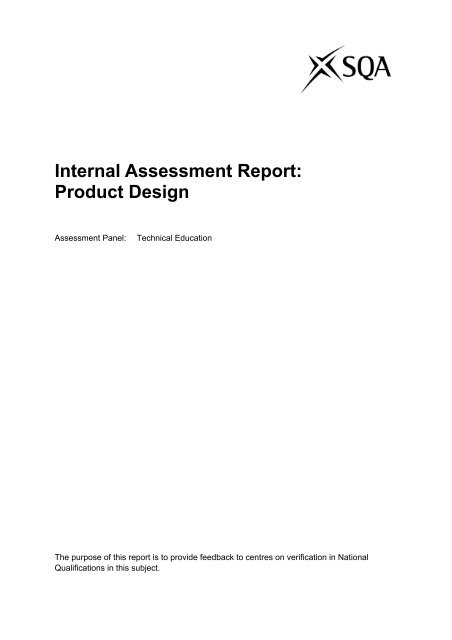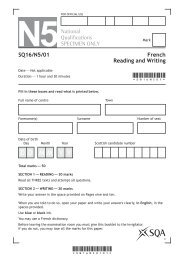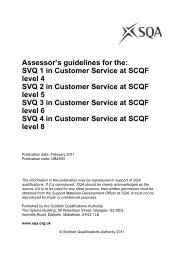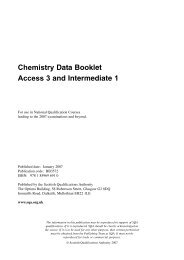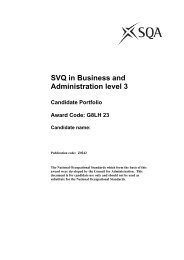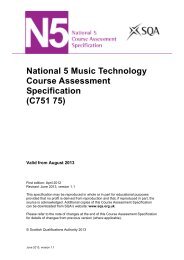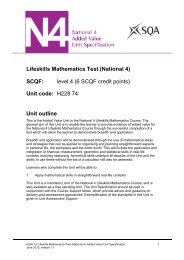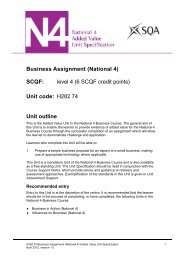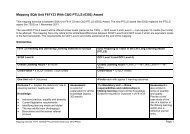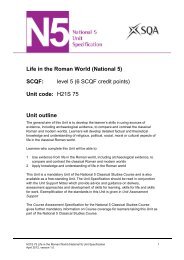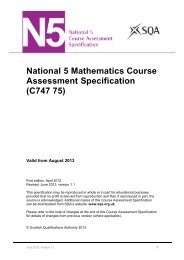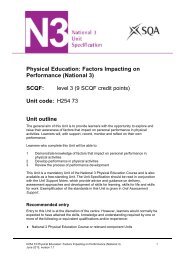Internal Assessment Report: Product Design
Internal Assessment Report: Product Design
Internal Assessment Report: Product Design
Create successful ePaper yourself
Turn your PDF publications into a flip-book with our unique Google optimized e-Paper software.
<strong>Internal</strong> <strong>Assessment</strong> <strong>Report</strong>:<br />
<strong>Product</strong> <strong>Design</strong><br />
<strong>Assessment</strong> Panel:<br />
Technical Education<br />
The purpose of this report is to provide feedback to centres on verification in National<br />
Qualifications in this subject.
National Units<br />
Titles/levels of National Units verified<br />
DF4V: <strong>Design</strong> Analysis — Intermediate 2 and Higher<br />
DF4W: Developing <strong>Design</strong> Proposal — Intermediate 2 and Higher<br />
DF4X: Manufacturing <strong>Product</strong>s — Intermediate 2 and Higher<br />
D130: <strong>Product</strong> <strong>Design</strong> Analysis — Advanced Higher<br />
D131: <strong>Product</strong> Development — Advanced Higher<br />
Feedback to centres<br />
General comments<br />
In total, 69 centres were verified. Twenty-four centres were visited in January, the rest were<br />
verified at the central event in April. Eighteen centres were verified in Unit DF4W, 47 in<br />
DF4V and one in DF4X. At Advanced Higher, two centres were verified in D130 and one<br />
centre in D131.<br />
Forty-three centres were ‘Accepted’, but 26 centres were ‘Not Accepted’ and were required<br />
to re-submit evidence. All centres were ‘Accepted’ after resubmission.<br />
Administrative errors in evidence accounted for a large number of ‘Not Accepted’ decisions.<br />
Errors included:<br />
♦ submission of evidence for wrong Unit<br />
♦ arithmetical errors in candidate scores<br />
♦ no evidence for one of the Outcomes<br />
♦ incorrect cut-offs used<br />
♦ NAB marking guidelines not followed<br />
A large number of centres did not include the Candidate Progress Sheet or supply any detail<br />
of where marks had been awarded. This made provision of detailed feedback very difficult.<br />
In a small number of centres there was evidence of a lack of standardisation of marking<br />
across different teaching groups. All of these errors could have been avoided by a more<br />
robust internal verification process within centres.<br />
The vast majority of centres that received visits were verified in Unit DF4V and 19 of the 24<br />
centres were accepted on the first visit.<br />
Eighteen centres were verified in DF4W. Eleven centres were ‘Not Accepted’; and most of<br />
the problems were caused by the evidence submitted for modelling and graphics.<br />
2
Advice on good practice and areas for further development<br />
DF4V <strong>Design</strong> Analysis — Intermediate 2 and Higher<br />
There has been a marked improvement in the assessment of this Unit. Centres have<br />
responded to advice, particularly that supplied during development visits and/or visiting<br />
verification.<br />
Outcome 1 — Evaluate a commercial product<br />
There has been an improvement in the marking of this Outcome. Most candidates are<br />
selecting appropriate products and there has been a movement away from evaluating<br />
products they are too familiar with, eg their mobile phone.<br />
The main reasons for ‘Not Accepted’ results were:<br />
♦ Marks can only be awarded for justification of selection of aspects. Centres often<br />
awarded marks for any correct statement.<br />
♦ The evaluation strategy must be marked using the band statements contained in the<br />
NAB. A number of centres awarded one mark per correct statement.<br />
♦ Marks can only be awarded for valid research. A number of centres incorrectly gave<br />
marks for inappropriate research or simple archived materials.<br />
♦ Conclusions must be marked using the band statements contained in the NAB. A<br />
number of centres awarded one mark per correct statement.<br />
Outcome 2 — Establish a design specification from a brief<br />
This Outcome continues to present problems. Many candidates seemed to be unclear about<br />
the difference between this Outcome and Outcome 1 and approached it as if they were<br />
evaluating a product. There were also a significant number of candidates who treated this as<br />
if they were developing a design proposal. Candidates should be continually reminded to<br />
direct their efforts toward producing a specification.<br />
The main reasons for ‘Not Accepted’ results were:<br />
♦ Many candidates started with a very vague brief. This caused problems throughout the<br />
whole Outcome. Candidates should be given a brief which is structured enough to allow<br />
them to do meaningful research.<br />
♦ A number of centres incorrectly gave marks for inappropriate research or simple<br />
archived materials. Marks can only be awarded for valid research.<br />
♦ The specification must be marked using the band statements contained in the NAB. A<br />
number of centres awarded one mark per correct statement.<br />
3
DF4W Developing <strong>Design</strong> Proposal — Intermediate 2 and Higher<br />
A significant number of centres produced excellent evidence for this Unit. However, a large<br />
number of centres were ‘Not Accepted’, largely due to missing evidence for some of the<br />
Outcomes, particularly in modelling and graphics.<br />
Outcome 1 — Produce a design proposal<br />
This was generally well assessed by centres. The main reason for ‘Not Accepted’ results<br />
was:<br />
♦ At Higher, a number of centres accepted evidence which was more appropriate to<br />
Intermediate 2 level. The evidence presented must be detailed enough to demonstrate<br />
the candidate’s design knowledge.<br />
Outcome 2 — Use graphic techniques during the production of a design<br />
proposal<br />
A number of candidates produced very high quality graphics and the Outcome was generally<br />
well assessed by centres.<br />
The main reasons for ‘Not Accepted’ results were:<br />
♦ Occasionally, marks were awarded to drawings that were not recognisable types.<br />
Reference should be made to NAB statements.<br />
♦ Occasionally, too many marks were awarded for computer-generated graphics.<br />
Reference should be made to NAB statements.<br />
♦ Often, too many marks were awarded for rendering. Marks in the top range (7–10) can<br />
only be awarded if at least three media have been used.<br />
It should be noted that if candidates have undertaken more than one design task to generate<br />
evidence for this Outcome they are required to submit the folio of work for each task to show<br />
that the graphic techniques were used during the production of a design proposal.<br />
Outcome 3 — Use modelling techniques during the production of a design<br />
proposal<br />
This Outcome was the main reason for ‘Not Accepted’ results. It would appear that a large<br />
number of candidates are not using modelling during the design process but are simply<br />
producing a model of their design proposal at the end of the process.<br />
The main reasons for ‘Not Accepted’ results were:<br />
♦ Inappropriate use of modelling. Models should be used for a purpose and they should be<br />
evident throughout the folio.<br />
♦ Lack of range of models. Very often a single model was produced and appeared at the<br />
end of the folio. Often several examples of the same type of model appeared at the end<br />
of the folio. Centres should note that candidates can achieve the maximum 5 marks for<br />
very quickly produced models which have validity during the idea generation and<br />
development stages of the folio.<br />
4
♦ Too many marks were awarded for computer models. Reference should be made to<br />
NAB statements.<br />
♦ Too many marks were awarded for practical skills. Reference should be made to NAB<br />
statements.<br />
It should be noted that if candidates have undertaken more than one design task to generate<br />
evidence for this Outcome they are required to submit the folio of work for each task to show<br />
that the modelling was used during the production of a design proposal.<br />
DF4X Manufacturing <strong>Product</strong>s — Intermediate 2 and Higher<br />
This Unit continues to raise very few issues at verification.<br />
D130: <strong>Product</strong> <strong>Design</strong> Analysis — Advanced Higher<br />
D131: <strong>Product</strong> Development — Advanced Higher<br />
A mixture of the new and old NABs was presented for verification. All centres were<br />
accepted. Exemplar material is being produced for the new NABs and this will aid centres.<br />
5


